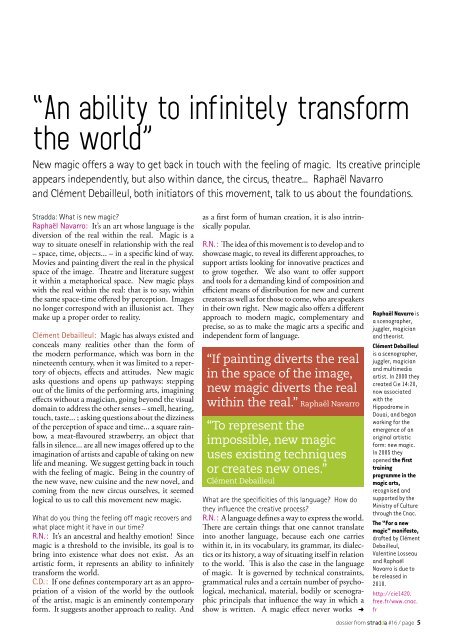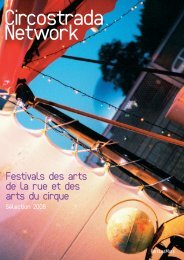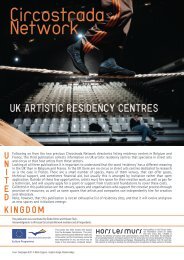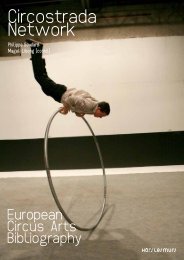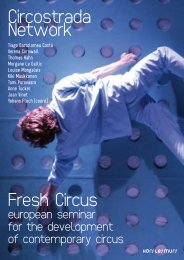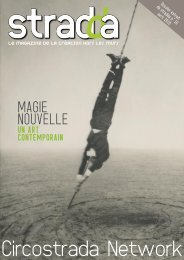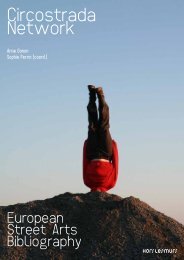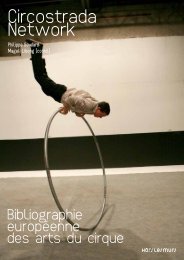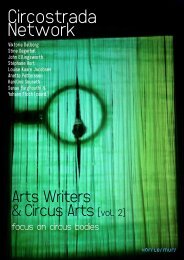MAGIE NOUVELLE - Circostrada Network
MAGIE NOUVELLE - Circostrada Network
MAGIE NOUVELLE - Circostrada Network
Create successful ePaper yourself
Turn your PDF publications into a flip-book with our unique Google optimized e-Paper software.
“An ability to infinitely transform<br />
the world”<br />
New magic offers a way to get back in touch with the feeling of magic. Its creative principle<br />
appears independently, but also within dance, the circus, theatre... Raphaël Navarro<br />
and Clément Debailleul, both initiators of this movement, talk to us about the foundations.<br />
Stradda: What is new magic<br />
Raphaël Navarro: It’s an art whose language is the<br />
diversion of the real within the real. Magic is a<br />
way to situate oneself in relationship with the real<br />
– space, time, objects... – in a specific kind of way.<br />
Movies and painting divert the real in the physical<br />
space of the image. Theatre and literature suggest<br />
it within a metaphorical space. New magic plays<br />
with the real within the real: that is to say, within<br />
the same space-time offered by perception. Images<br />
no longer correspond with an illusionist act. They<br />
make up a proper order to reality.<br />
Clément Debailleul: Magic has always existed and<br />
conceals many realities other than the form of<br />
the modern performance, which was born in the<br />
nineteenth century, when it was limited to a repertory<br />
of objects, effects and attitudes. New magic<br />
asks questions and opens up pathways: stepping<br />
out of the limits of the performing arts, imagining<br />
effects without a magician, going beyond the visual<br />
domain to address the other senses – smell, hearing,<br />
touch, taste... ; asking questions about the dizziness<br />
of the perception of space and time... a square rainbow,<br />
a meat-flavoured strawberry, an object that<br />
falls in silence... are all new images offered up to the<br />
imagination of artists and capable of taking on new<br />
life and meaning. We suggest getting back in touch<br />
with the feeling of magic. Being in the country of<br />
the new wave, new cuisine and the new novel, and<br />
coming from the new circus ourselves, it seemed<br />
logical to us to call this movement new magic.<br />
What do you thing the feeling off magic recovers and<br />
what place might it have in our time<br />
R.N. : It’s an ancestral and healthy emotion! Since<br />
magic is a threshold to the invisible, its goal is to<br />
bring into existence what does not exist. As an<br />
artistic form, it represents an ability to infinitely<br />
transform the world.<br />
C.D. : If one defines contemporary art as an appropriation<br />
of a vision of the world by the outlook<br />
of the artist, magic is an eminently contemporary<br />
form. It suggests another approach to reality. And<br />
as a first form of human creation, it is also intrinsically<br />
popular.<br />
R.N. : The idea of this movement is to develop and to<br />
showcase magic, to reveal its different approaches, to<br />
support artists looking for innovative practices and<br />
to grow together. We also want to offer support<br />
and tools for a demanding kind of composition and<br />
efficient means of distribution for new and current<br />
creators as well as for those to come, who are speakers<br />
in their own right. New magic also offers a different<br />
approach to modern magic, complementary and<br />
precise, so as to make the magic arts a specific and<br />
independent form of language.<br />
“If painting diverts the real<br />
in the space of the image,<br />
new magic diverts the real<br />
within the real.” Raphaël Navarro<br />
“To represent the<br />
impossible, new magic<br />
uses existing techniques<br />
or creates new ones.”<br />
Clément Debailleul<br />
What are the specificities of this language How do<br />
they influence the creative process<br />
R.N. : A language defines a way to express the world.<br />
There are certain things that one cannot translate<br />
into another language, because each one carries<br />
within it, in its vocabulary, its grammar, its dialectics<br />
or its history, a way of situating itself in relation<br />
to the world. This is also the case in the language<br />
of magic. It is governed by technical constraints,<br />
grammatical rules and a certain number of psychological,<br />
mechanical, material, bodily or scenographic<br />
principals that influence the way in which a<br />
show is written. A magic effect never works ➜<br />
Raphaël Navarro is<br />
a scenographer,<br />
juggler, magician<br />
and theorist.<br />
Clément Debailleul<br />
is a scenographer,<br />
juggler, magician<br />
and multimedia<br />
artist. In 2000 they<br />
created Cie 14:20,<br />
now associated<br />
with the<br />
Hippodrome in<br />
Douai, and began<br />
working for the<br />
emergence of an<br />
original artistic<br />
form: new magic.<br />
In 2005 they<br />
opened the first<br />
training<br />
programme in the<br />
magic arts,<br />
recognised and<br />
supported by the<br />
Ministry of Culture<br />
through the Cnac.<br />
The “For a new<br />
magic” manifesto,<br />
drafted by Clément<br />
Debailleul,<br />
Valentine Losseau<br />
and Raphaël<br />
Navarro is due to<br />
be released in<br />
2010.<br />
http://cie1420.<br />
free.fr/www.cnac.<br />
fr<br />
dossier from stradda #16 / page 5


